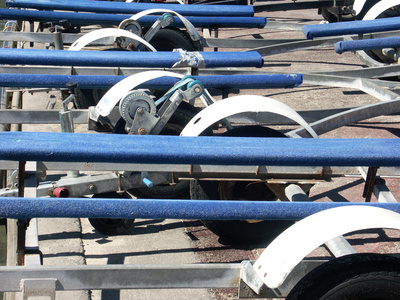
Buying and fitting a boat trailer to your boat requires just as much knowledge and forethought as purchasing the boat. Flat bottom, tri-hull and deep V-hull designs all require a certain setup and configuration. Fitting the wrong boat trailer to your boat invites disaster if the size, weight and configuration of the trailer does not conform to the profile of the boat. Bigger trailers do not necessarily mean better hauling characteristics. The boat owner should familiarize himself with some basic rules of thumb before fitting his boat to a trailer.
Use a tape measure to determine the distance from the bow eye of the boat to the furthest part of the transom. Your trailer should fit within this length or slightly longer, measuring it from the winch post to the back support frame of the trailer.
Measure the width of the boat from the bottom side of the chine (outside hull edge) to the other side of the chine. Your boat should fit squarely inside the hull stabilizer rails or on the rollers with enough adjustment on the rails or rollers to move in or out to fit the hull profile. Measure the roller or rail diameter with a tape measure from edge to edge across the width of the trailer, allowing for the length of the adjustment notches in the roller supports or hull rails.
Use a calculator to determine the total package weight of your boat. Refer to your boat owner's manual for your boat's empty weight, then add the engine weight, plus the regular amount of gas, water and gear on board. Add seven pounds for every gallon of gas; add eight pounds for every gallon of water, then total up the average weight of the gear on board. Take the total gross package weight times six percent and write the figure down. For double axle trailers, take the gross package weight times five percent.
Determine the gross package weight times your percentage to find the gross tongue weight for your hitch. Refer to your hitch specifications to see if the tongue weight does not exceed tolerances. If the tongue weight exceeds specifications, you can move the axle extension on the trailer, via notches, to accommodate the proper tongue weight. If the tongue weight reads too heavy, the trailer extension should be able to move forward 1 inch for every 10 to 15 pounds. Move it back, using the same formula for lighter tongue weights.
Make sure the bow stop roller on the trailer fits snug above the bow eye, and that the winch can wind the boat on a horizontal plane, and not deviate up or down. Fit the boat on the trailer and tighten the winch strap, securing the boat bow into the bow stop roller, to make sure it fits correctly.
Make sure the keel rollers fit up against the deepest part of the hull, and that the boat keel does not drag over any part of the trailer frame. Examine the adjustments tolerances of the keel rollers to make sure they extend high enough. Use a socket and wrench to loosen the adjustment bolts and extend the keel rollers. The side rollers or hull stabilizers should also be able to fit flush against both sides of the hull, with at least two adjustment notches left for expansion or contraction.
Adjust the side rollers or hull stabilizers with a socket and wrench to determine the extent of their reach. Once all the adjustments have been made, tighten all the adjustment bolts for the keel rollers, hull stabilizers and side rollers with a socket and wrench. If the trailer has transom tie-down straps, fit them to the transom and manually adjust the straps to the trailer hooks for a tight fit.